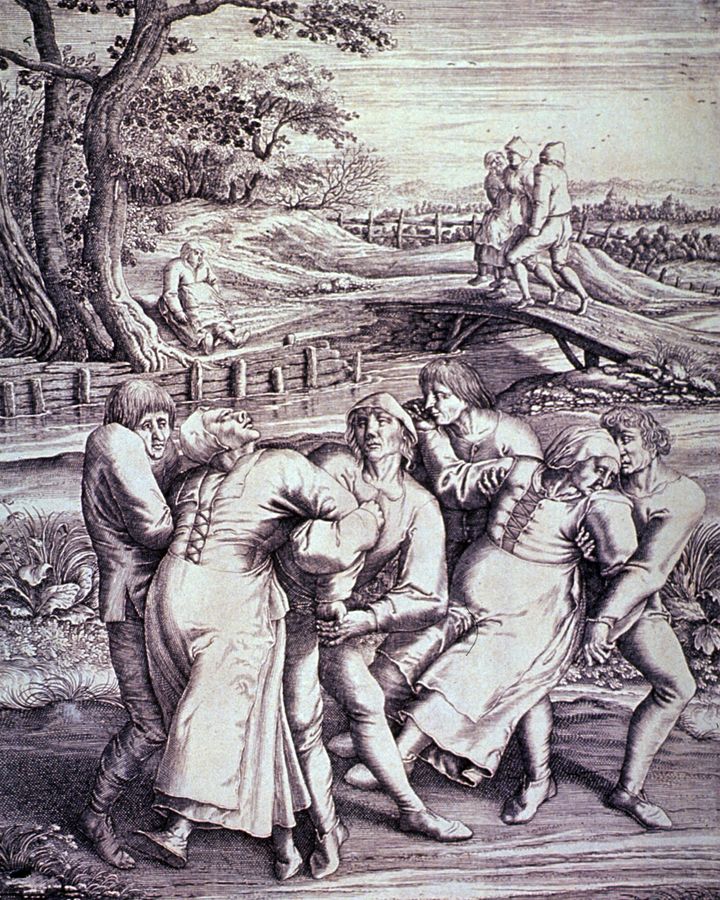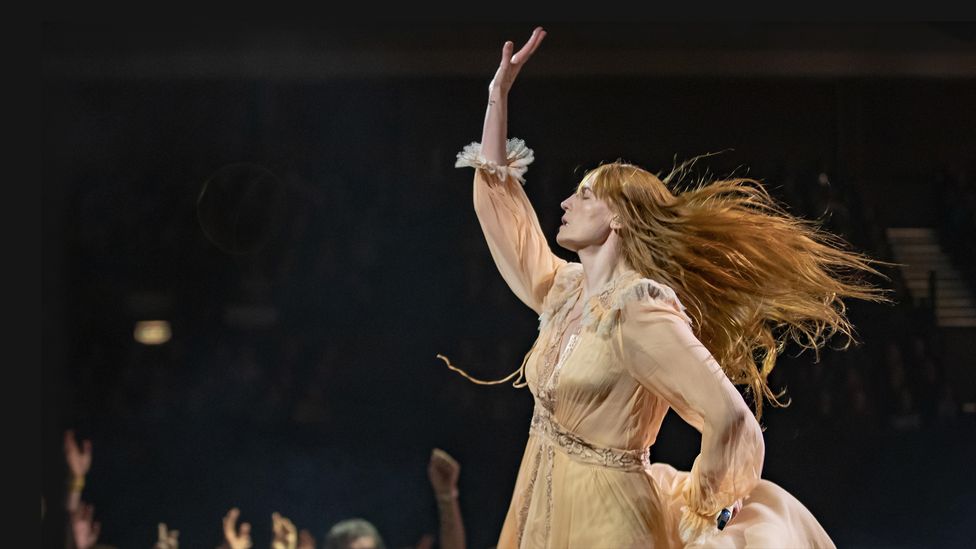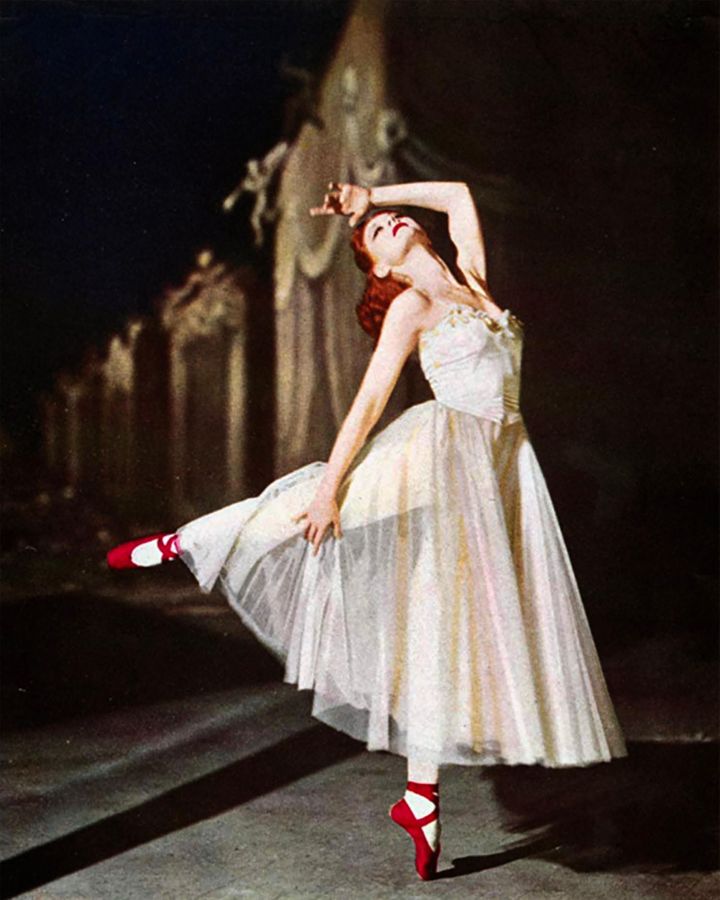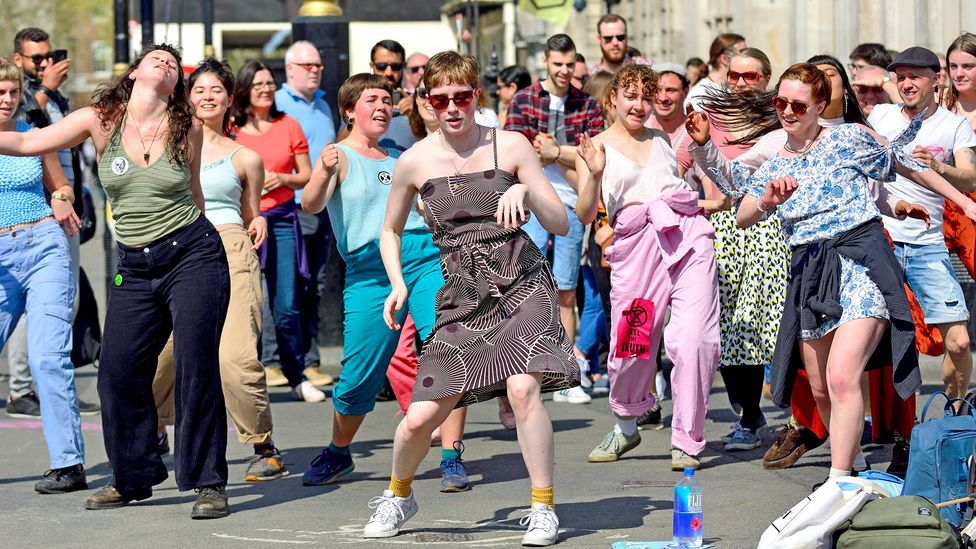People who ‘danced themselves to death’

Like all good plague stories, this one begins with omens. A star streaks across the sky. Fields flood. Extreme cold is followed by extreme heat, which is followed, inevitably, by extreme hunger. On a sweltering summer’s day in July 1518 a woman called Frau Troffea steps into a square in Strasbourg and begins to dance. At first those around her only watch, curiosity piqued by this unusual public display. They watch a woman who will not, cannot, stop. She dances for nearly a week, felled occasionally by exhaustion but largely undaunted by the body’s other warning signs: pain, hunger, shame. There is no music. Her heart keeps the tempo, working hard to make the motion continue.
More like this:
– How to ‘re-wild’ your life
– The best books of the year so far
– The most dangerous dances in history
By the time she is taken away, it is too late. Others have joined. By August there will be hundreds. Like her, they cannot explain themselves. They dance as if compelled, feet bloodied and limbs twitching. A poem taken from a contemporary chronicle describes “women and men who dance and hop…/ In the public market, in alleys and streets,/ Day and night” until the “sickness” finally stops. Further chronicles outline the measures taken by the authorities in response. One writer describes dancers being carted off to St Vitus’s shrine outside the city, where they are “given small crosses and red shoes”. Another mentions more direct arrangements made for the dancers to tire them into submission, with “persons… specially appointed to dance with them for payment, to the music of drums and pipes”. This does not help. “All this was of no avail, and many danced themselves to death.”

Many examples of “dance plagues” were recorded in Europe during the medieval and early modern era (Credit: Alamy)
In the 400 or so years since this bizarre event – Strasbourg’s so-called “dance plague” – occurred, many theories have been proffered to explain what exactly happened. It is an event that grips us to this day, inviting retellings, and inspiring artists and creatives to put their own spin on these strange happenings. This week, two major works themed around dance plagues are being released: pop star Florence + The Machine’s album Dance Fever, and bestselling author Kiran Millwood Hargrave’s The Dance Tree. Both have used the idea of choreomania (as the phenomenon was later dubbed) to create highly immersive works that meditate on constraint and rapture.
Though it is now the most famous example, Strasbourg was not the only “dance plague” to hit Europe during the medieval and early modern era. Many instances of uncontrolled or threatening dancing were recorded in Germany, France, and other parts of the Holy Roman Empire. In earlier centuries these events were interpreted as divine punishment or demonic possession, remedied with religious solutions like processions, masses, or direct intervention from priests. Two decades before the summer of 1518, a cleric in Strasbourg named Sebastian Brant wrote in his satirical allegory The Ship of Fools “that dance and sin are one in kind,” blaming Satan for all this “giddy dancing gayly done”.
Several years after the incident in Strasbourg, the physician Paracelsus embarked on a series of treatises on choreomania including The Diseases That Deprive Man of His Reason, such as St. Vitus’s Dance, Falling Sickness, Melancholy, and Insanity, and Their Correct Treatment. Paracelsus, who is now best known for his pioneering work on chemistry in medicine, argued that this phenomenon was probably more earthly than divine. He suggested that a person’s “laughing veins” could provoke a “ticklish feeling” that rose from their limbs to their head, clouding judgment and provoking extreme motion until the frenzied blood was calmed.
This wasn’t to absent sin entirely. Those most commonly afflicted by the dance, Paracelsus wrote, included “whores and scoundrels who take pleasure in guitar and lute playing… satisfy [ing] all voluptuousness, bodily pleasure, imagination and fancy.” His elaborations on possible causes were less archaic. He argued that “imagination” was a more plausible culprit than God or the devil. The imagination, Paracelsus said, “doth not onely fly out of one house into another… but also most swiftly passeth from one City and Country into another, so that by the imagination onely of one person, the Pestilence may come into some whole City or Country.”
This interpretation aligns more closely with current theories about mass psychogenic illness, induced by febrile political and social circumstances. For a while there were speculations about whether ergot – a mould found in rye stalks that could bring about powerful hallucinations and convulsions – might be responsible, but these have largely been dismissed. John Waller, the author of the most popular non-fiction book on the subject A Time to Dance, A Time to Die: The Extraordinary Story of the Dancing Plague of 1518, instead characterises choreomania as a “psychic epidemic” akin to others around the world involving other involuntary bodily responses such as laughing or fainting.
Modern choreomania
Ultimately, the story of a surreal summer in Strasbourg is just that: a story. Mass dancing of some form is documented in at least six different contemporaneous chronicles, the dancers’ motions reportedly continuing for weeks. Frau Troffea is named as the instigator in several of them. Beyond that, details begin to diverge. Various starting dates are given. Different methods of dealing with the phenomenon are emphasised. Like plenty of other historical events, a portrait is drawn from fragments.

Florence + the Machine’s new album Dance Fever is inspired by the phenomenon of – and includes a track entitled – “choreomania” (Credit: Alamy)
Regardless of the actual facts, the tale continues to grip our imagination: a lone figure who sparks a mass movement; a dance that is so captivating, so consuming, that it transcends individual will and physical limitation, sometimes with deadly consequences. It is the kind of event that ensnares even those of us who continue to write about it today, our prose filled with conjured details about the damage done to weary toes or the tick and pump of Frau Troffea’s heart.
Uncontrollable dance has a bewitching effect on those who contemplate it. One only has to think of the popular Hans Christian Andersen fairy tale The Red Shoes, with its cursed scarlet leather slippers that condemn their owner into a dance so tortuous that she eventually finds an executioner to hack off her own feet. It is a horrible tale, and people love it. Although its moral implications are relatively straightforward (a good old dose of punishment for vanity: the shoes’ wearer put through this ordeal because she dared to covet such beautiful footwear in the first place), its darker suggestions of possession and incessant movement have inspired numerous works including a Powell and Pressburger film, a Kate Bush album, and several ballets.
This summer, the dance plague itself returns in earnest. Florence + The Machine’s fifth album Dance Fever, released today, takes its cues from the unstoppable impulses of choreomania. The accompanying release notes outline frontwoman Florence Welch’s interest in this volatile meeting point between energetic motion and moral panic, as well as touching on the subject’s obvious resonance on an album recorded during the Covid-19 pandemic, when “the whirl of movement and togetherness” was both missed and anticipated. A dance plague is an apt theme for someone who wants to explore uncertainty and change. The opening lines of the song Choreomania – written before the pandemic – are uncannily prescient: “And I’m freaking out in the middle of the street / With the complete conviction of someone who has never actually had anything really bad happen to them.” It’s also apt for a singer so consistently preoccupied by the body as a tool of expression. Music videos for the album’s singles King and Heaven is Here feature the same group of dancers who writhe around Welch, their motions uninhibited as they stamp their feet and dash their skirts.
Meanwhile the latest novel from author Kiran Millwood Hargave, The Dance Tree, looks specifically at the supposed events of the 1518 Strasbourg incident through the lives of women swept up in it. In Millwood Hargrave’s version, the dancing plague becomes a female-only affliction: beginning with Frau Troffea, moving “as though she is being hauled between two devilish ropes caught about her limbs”, and building to an overwhelming crush of “pulsing bodies” that disrupt and disturb everything around them. Written in the third person, the story is largely seen through the eyes of Lisbet, a pregnant beekeeper who is hardened to loss and seeking to untangle the mysteries of the family she has married into. She is an onlooker, not a participant. But as the dance changes the nature of the city, it changes her too. Revelations unfold. Desires come to a head. This narrative thread is woven together with brief portraits of the women who join the dance: women who have lost their fathers, their sons, or their minds; women who have known passion, who have been denied it; women who remain bystanders until they can’t resist the promise of freedom found in the centre of a swaying crowd.
Ecstasy and anger
It was perhaps inevitable that the dancing plague regained popularity now. The last two years have yielded feverish interest in the many pandemics that have gone before us, from the Black Death to the Spanish Flu. We have looked to them not only for comparison, but also, seemingly, to reassure ourselves that all epidemics eventually end. Within that, something tenuously classed as a plague where the contagion isn’t sickness, but movement was always going to be alluring. As Welch acknowledges, one of the things lost during lockdown was the communality of dancing: that exquisite feeling of being physically proximate to hundreds of other people, everyone carried by music that commands the muscles and turns a sea of strangers into fellow travellers bound by shared experience.

Powell and Pressburger’s The Red Shoes is one of many artworks fascinated by the idea of someone “possessed” by dance (Credit: Alamy)
It’s an infectious preoccupation. In July 2020, Jonathan Glazer debuted a 10-minute film titled Strasbourg 1518 (BBC Films/ Artangel) featuring solo performers dancing until they dropped. This year, with theatre back in full swing, productions including The Maladies at London’s Almeida Theatre, Dance to the Bone at Cardiff’s Sherman Theatre, and Mette Ingvartsen’s The Dancing Public (currently on tour across Europe) have all alluded to the events in Strasbourg, using them to frame meditations on oppression, disconnection, and mass movement.
The sensory appeal of this phenomenon isn’t entirely coronavirus specific. It speaks to other contemporary concerns. “I think the more our lives are pressured, and regimented, and time managed… the more we have this need to produce and be efficient, and the more our public spaces are cordoned and policed… the more the fantasy, the dream, the urge for letting loose [grows] strong,” says Kélina Gotman, author of Choreomania: Dance and Disorder. Gotman’s book, which is largely concerned with the pathologisation of choreomania, is less interested in the origins of any bouts of dancing than it is in how these moments have been written about, interpreted, and used to justify different ideologies.
Letting loose is an idea central to both Dance Fever and The Dance Tree. “There is something soaring, hopeful: an abandonment,” Millwood Hargrave writes in the latter of the growing crowd. The dance plague as it exists in her book is a situation of disorder, but also an enraptured refuge. “I wanted to look at the feeling of being swept up in something so incredible, and transcendent, and weird,” she tells me. “Ultimately, it’s a complete collective ecstasy.”
This idea of dance as an ecstatic space finds parallels in Dance Fever. “But I hear the music, I feel the beat/ And for a moment, when I’m dancing, I am free,” Welch sings in Free, her voice briefly striking a note of vulnerability before it roars once more. Transcendence in all its guises is a frequent theme in Welch’s lyrics, whether she’s exploring youthful attempts to escape herself (via drinking, drug taking, denying herself food) or meditating on the overwhelming fullness of love. Often, she too reaches a pitch of rapture, her songs not only speaking of abandonment but encouraging it in their incantatory rhythms and swelling crescendos. “I am free,” she sings again and again, until we feel it too.
Freedom is not a state to be taken for granted. In The Dance Tree, there are explicit points to be made about the autonomy of women – “female rage and female desire” is how Millwood Hargrave characterises the novel’s central preoccupation – and the power found in becoming an object of fear. Dancing is not always pretty. It can be ugly, scary, sweaty, full of jerking limbs and grimaced expressions. It is a very literal way of asserting autonomy. Look, it says, you cannot stop me from moving.

Dancing can be a powerful tool of physical protest – and indeed protests have been dismissed as choreomania (Credit: Alamy)
In the heavily claustrophobic religious setting of The Dance Tree, dancing also goes against the grain. It is, as Paracelsus so helpfully reminds us, much too pleasurable to be anything other than suspect. “Dance has such a huge role in so many cultures outside our own, particularly in Indian culture,” Millwood Hargrave explains. “In terms of faith and movement… they are just absolutely perfect bedfellows, because the purest expression of devotion is in body.” But within religious institutions that demand quiet piety, such gestures become dangerous. “It’s a really interesting thing to me that these women will never have been encouraged to move….” continues Millwood Hargrave. “In every other way church is so theatrical in the place and time of the book: these beautiful buildings, scent, incense, the beeswax, the clothes, it’s all so camp and so theatre. But once you’re in there, you’re still and you’re silent… It’s theatre, without the heat, without the actual bodily connection between people.”
A dance plague for every age
Events of mass disorder have always captivated artists. There is something fundamentally fascinating in a moment where the social fabric breaks, convention replaced with much weirder and more inexplicable happenings. In the case of choreomania, what emerges is not only a sense of entrancement or self-destruction (another popular artistic theme), but physical protest. Currently, the idea of a dance plague registers not only as an oddity, but something more liberatory. As scary as an unstoppable dance might be, there is an allure to it too. What might happen if we allowed ourselves to be properly carried away? What could be achieved with that feeling if it was replicated in the bodies of hundreds of other people moving around us?
This was not always the case. As Gotman explores in her book, once upon a time a dancing plague – however it was conceived – was something to be viewed with suspicion. In her research on 19th-Century approaches to choreomania, she discovered an alarmed attitude wrapped up in colonial thought and fear of otherness. “There was a real articulation of a version of modernity, as being in contrast to what was understood as more feminine, more animal, more wild, and untamed,” she tells me of the medical and historical writings she discovered in the Victorian era. “There was a racist and highly gendered discourse that was taking shape.”
At that point, when contextualising new perceived instances of choreomania, the medieval period was a convenient frame for understanding it. “The medieval… was compared to the African, largely as this kind of backward, non-European, pre-modern [period],” she explains. The very concept of “dance mania” was a useful political tool, allowing cross-comparison with – and dismissal of – protests and practises involving any element of physical movement. Gotman gives the example of puppet ruler King Radama II, who took control of Madagascar in 1861. When his people showed their displeasure, “exercising their right to protest against these kingdoms [that] sold off their lands to the Europeans,” with the king eventually deposed, it was easy for colonial missionaries to dismiss these actions as just another example of choreomania, transmuting a political protest into a mere instance of madness.
Now the prevailing mood has shifted. It is precisely the femininity and otherness of a dancing plague that makes it interesting. For today’s artist or thinker, it is both historic curio and symbol. At the centre is a simple idea. A group of people start to dance and can’t stop. But why they dance, and to what ends, remains an open-ended question: one that can be asked again and again, with different answers depending on what is being sought. Madness. Hunger. Protest. Freedom. Pleasure. Ecstasy. In the imagination, however, the dancers’ feet remain forever in motion, moving to their own, inscrutable rhythm.
Dance Fever by Florence + the Machine and The Dance Tree by Kiran Millwood Hargrave are out now.
If you would like to comment on this story or anything else you have seen on BBC Culture, head over to our Facebook page or message us on Twitter.
And if you liked this story, sign up for the weekly bbc.com features newsletter, called The Essential List. A handpicked selection of stories from BBC Future, Culture, Worklife and Travel, delivered to your inbox every Friday.








